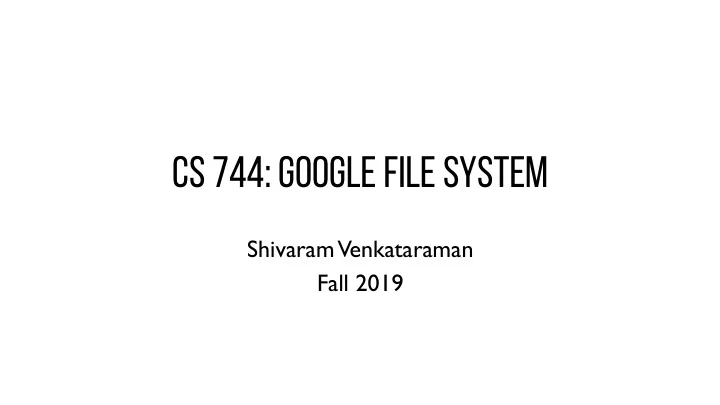

CS 744: GOOGLE FILE SYSTEM Shivaram Venkataraman Fall 2019
ANNOUNCEMENTS - Assignment 1 out later today - Group submission form - Anybody on the waitlist?
OUTLINE 1. Brief history 2. GFS 3. Discussion 4. What happened next?
HISTORY OF DISTRIBUTED FILE SYSTEMS
SUN NFS RPC RPC Client Client File Server Local FS Client Client RPC RPC
/ backups home etc bin bak1 bak2 bak3 tyler .bashrc 537 p1 p2 /dev/sda1 on / /dev/sdb1 on /backups NFS on /home
File HANDLES Client Server Local FS NFS Local FS Examples open read
CACHING Client 2 Server NFS Local FS t2 cache: A cache: B t1 Client cache records time when data block was fetched (t1) Before using data block, client does a STAT request to server - get’s last modified timestamp for this file (t2) (not block…) - compare to cache timestamp - refetch data block if changed since timestamp (t2 > t1)
NFS FEATURES NFS handles client and server crashes very well; robust APIs that are: - stateless: servers don’t remember clients - idempotent: doing things twice never hurts Caching is hard, especially with crashes Problems: – Consistency model is odd (client may not see updates until 3s after file closed) – Scalability limitations as more clients call stat() on server
ANDREW FILE SYSTEM - Design for scale - Whole-file caching - Callbacks from server
WORKLOAD PATTERNS (1991)
WORKLOAD PATTERNS (1991)
OceanSTORE/PAST Wide area storage systems Fully decentralized Built on distributed hash tables (DHT)
GFS: WHY ?
Components with failures Files are huge ! GFS: WHY ? Applications are different
GFS: WORKLOAD ASSUMPTIONS “Modest” number of large files Two kinds of reads: Large Streaming and small random Writes: Many large, sequential writes. No random High bandwidth more important than low latency
GFS: DESIGN - Single Master for metadata - Chunkservers for storing data - No POSIX API ! - No Caches!
CHUNK SIZE TRADE-OFFS Client à Master Client à Chunkserver Metadata
GFS: REPLICATION - 3-way replication to handle faults - Primary replica for each chunk - Chain replication (consistency) - Dataflow: Pipelining, network-aware
RECORD APPENDS Write Client specifies the offset Record Append GFS chooses offset Consistency At-least once Atomic Application level
MASTER OPERATIONS - No “directory” inode! Simplifies locking - Replica placement considerations - Implementing deletes
FAULT TOLERANCE - Chunk replication with 3 replicas - Master - Replication of log, checkpoint - Shadow master - Data integrity using checksum blocks
DISCUSSION
GFS SOCIAL NETWORK You are building a new social networking application. The operations you will need to perform are (a) add a new friend id for a given user (b) generate a histogram of number of friends per user. How will you do this using GFS as your storage system ?
GFS EVAL List your takeaways from "Figure 3: Aggregate Throughputs”
GFS SCALE The evaluation (Table 2) shows clusters with up to 180 TB of data. What part of the design would need to change if we instead had 180 PB of data?
WHAT HAPPENED NEXT
Keynote at PDSW-DISCS 2017: 2nd Joint International Workshop On Parallel Data Storage & Data Intensive Scalable Computing Systems
GFS EVOLUTION Motivation: - GFS Master One machine not large enough for large FS Single bottleneck for metadata operations (data path offloaded) Fault tolerant, but not HA - Lack of predictable performance No guarantees of latency (GFS problems: one slow chunkserver -> slow writes)
GFS EVOLUTION GFS master replaced by Colossus Metadata stored in BigTable Recursive structure ? If Metadata is ~1/10000 the size of data 100 PB data → 10 TB metadata 10TB metadata → 1GB metametadata 1GB metametadata → 100KB meta...
GFS EVOLUTION Need for Efficient Storage Rebalance old, cold data Distributes newly written data evenly across disk Manage both SSD and hard disks
Heterogeneous storage F4: Facebook Blob stores Key Value Stores
NEXT STEPS - Assignment 1 out tonight! - Next week: MapReduce, Spark
Recommend
More recommend